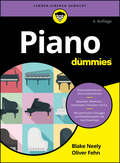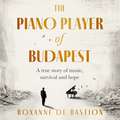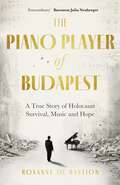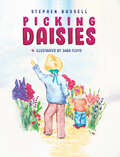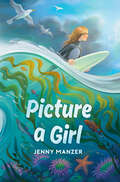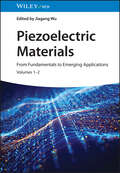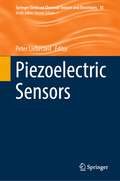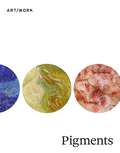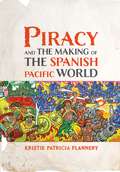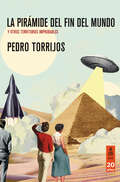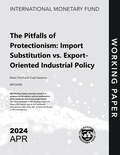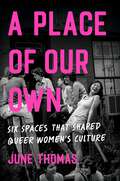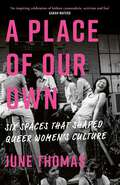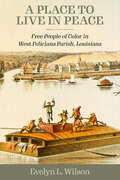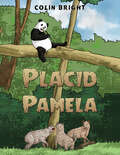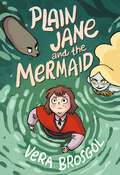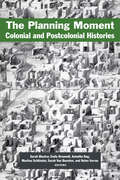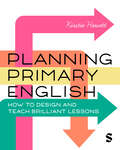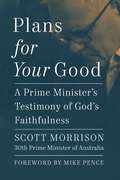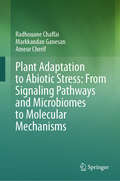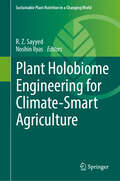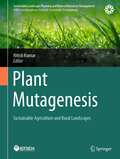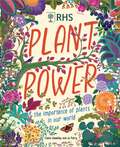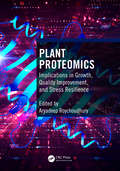- Table View
- List View
Piano für Dummies (Für Dummies)
by Blake Neely Oliver FehnTasten Sie sich an das Pianospielen heran Kaum ein Instrument fasziniert so wie das Piano, sei es als Klavier, Keyboard oder Orgel. Blake Neely und Oliver Fehn bringen Ihnen alles bei, was Sie über die 88 Tasten, drei Pedale und zehn Finger wissen müssen. Sie erhalten eine Einführung in die Rhythmen, Melodien und Harmonien, in die Tonarten Akkorde und Co. So lernen Sie Schritt für Schritt Noten zu lesen, Ihre Finger auf die richtigen Tasten zu setzen, erste Lieder zu spielen und Ihre Spieltechnik nach und nach zu verfeinern. Hörbeispiele zum Download helfen Ihnen dabei. Lernen Sie Klavierspielen ohne Vorkenntnisse mitbringen zu müssen! Sie erfahren Wissenswertes zum Kauf Ihres Instruments Wie eine Tonleiter aufgebaut ist Wie Sie Akkorde greifen – in Dur und Moll Wie Sie Ihr Klavierspiel mit Tremolos, Trillern und Dynamik aufpeppen
The Piano Player of Budapest: A True Story of Holocaust Survival, Music and Hope
by Roxanne de BastionOne man, his piano and their miraculous survival.'Extraordinary' Baroness Julia Neuberger'Stunning. A beautiful blend of action, poetry, thought-provoking comment and music ... just brilliant' James Ainscough OBE'A gripping narrative of suffering, loss and survival, with music at its heart' Fiona MaddocksAll future, freedom and success lay ahead of young pianist Stephen de Bastion in 1930s Hungary. Life whirled headily around cocktails, romance, applause and the buzz of Budapest late into the night. Then, 1939. Stephen's world disintegrates and this becomes a story of his brutal descent, of his time in labour camps, of Mauthausen and Gunskirchen and the unimaginable horrors he endured during the Holocaust as a man of Jewish descent. Yet, this is also a tale of extraordinary escape ... and the piano, waiting for him.The same piano that Roxanne de Bastion, his granddaughter, inherits when her father dies. It has been in the family over one hundred years but it is only when, deep in grief, she discovers a cassette recording of Stephen, that the astonishing history of the piano, the man and her family begins to unravel. Weaving together his original recordings, unpublished memoirs, letters and documents, Roxanne sings out her grandfather's story of music and hope, lost and found. Luminous and profoundly moving, this book captures the great spirit of one man in the face of darkness and the hope that echoes down through generations.
The Piano Player of Budapest: A True Story of Holocaust Survival, Music and Hope
by Roxanne de BastionOne man, his piano and their miraculous survival.'Extraordinary' Baroness Julia Neuberger'Stunning. A beautiful blend of action, poetry, thought-provoking comment and music ... just brilliant' James Ainscough OBE'A gripping narrative of suffering, loss and survival, with music at its heart' Fiona MaddocksAll future, freedom and success lay ahead of young pianist Stephen de Bastion in 1930s Hungary. Life whirled headily around cocktails, romance, applause and the buzz of Budapest late into the night. Then, 1939. Stephen's world disintegrates and this becomes a story of his brutal descent, of his time in labour camps, of Mauthausen and Gunskirchen and the unimaginable horrors he endured during the Holocaust as a man of Jewish descent. Yet, this is also a tale of extraordinary escape ... and the piano, waiting for him.The same piano that Roxanne de Bastion, his granddaughter, inherits when her father dies. It has been in the family over one hundred years but it is only when, deep in grief, she discovers a cassette recording of Stephen, that the astonishing history of the piano, the man and her family begins to unravel. Weaving together his original recordings, unpublished memoirs, letters and documents, Roxanne sings out her grandfather's story of music and hope, lost and found. Luminous and profoundly moving, this book captures the great spirit of one man in the face of darkness and the hope that echoes down through generations.
Picking Daisies
by Stephen RussellGemma goes for a short stay in the countryside with her gran and when her parents arrive to collect her, they have a pleasant surprise.
Picture a Girl
by Jenny ManzerKey Selling Points In their small coastal town, Addie lives with her mom and little brother...until her mom (who struggles with alcoholism and depression) leaves and Addie is forced to take care of herself and her brother, without anyone finding out. Refusing the easy answers, Picture a Girl looks unflinchingly at the life of an 11-year-old girl who has learned to be an adult in her mother's absence and to lie to keep her family together. Shows surfing in a less glamorous way, as Addie's mother's only true "happy place" and an obsession that can take precedence over her kids—but also reveals it as a way forward for the family, after she returns and promises to give Addie and Billy regular surfing lessons. Jenny Manzer is the author of Save Me, Kurt Cobain , which was nominated for the Bolen Books Children's Book Prize, and My Life as a Diamond , which was nominated for numerous awards and named one of Bank Street College of Education's Best Books of the Year.
Piezoelectric Materials: From Fundamentals to Emerging Applications
by Jiagang WuPiezoelectric Materials Analyze the foundational materials of the electronics industry In recent years piezoelectric materials have become one of the world’s most important classes of functional materials. Their ability to convert between mechanical and electrical energy makes them indispensable for sensors, transducers, actuators, catalysts, and many other foundational electronic devices. As electronics industries expand at unprecedented rates, the range of applications for piezoelectric materials continues to grow. Piezoelectric Materials offers a comprehensive overview of this group of materials, its key properties, and its applications. Beginning with the fundamental science of piezoelectric phenomena, it then analyzes different the numerous different classes of piezoelectric materials and their current and future industrial functions. The result is essential for engineers and materials scientists working in any number of areas. Piezoelectric Materials readers will also find: Analysis of materials types include lead-based and lead-free piezoelectric materials, textured piezoceramics, piezoelectric thin films, and many moreDetailed discussion of applications including dielectric energy storage and biomedical technologyAuthorship by a leading researcher of piezoelectric materials Piezoelectric Materials is ideal for materials scientists, electronic engineers, polymer chemists, solid state chemists, and any other researchers or professionals working with these key materials.
Piezoelectric Sensors (Springer Series on Chemical Sensors and Biosensors #18)
by Peter LieberzeitThis book provides a comprehensive overview of piezoelectric sensor devices and instrumentation and their use for chemical and biochemical analysis. Sensors relying on established transducers, such as the quartz crystal microbalance (QCM) and the surface acoustic wave resonator (SAW) are covered, and novel devices like surface transverse wave (STW) resonators, film bulk acoustic resonators (FBAR) as well as non-piezoelectric devices with mass-sensitive properties are presented. As their name implies, such devices respond directly to mass changes on their surfaces and thus address the most fundamental quality of any analytes. First, the book presents the fundamentals of new measuring strategies with these devices. Then, it introduces a variety of chemo- and biosensing application scenarios of these devices. In addition, the book covers both the state-of-the-art of academic research and prospects concerning the commercialization of these sensors. Given its scope, the book is of interest to academics, specialists in industry, and advanced students in the areas of analytical chemistry, rapid analysis, and sensor technology, giving them the unique possibility to familiarize themselves with this chemical sensing strategy. Readers will benefit from the coverage of both cutting-edge research results and applications that help bridge the gap between academia and industry.
Pigments (ART/WORK)
by Ittai Weinryb Barbara H. Berrie Karin Leonhard Caroline FowlerA concise illustrated history of one of art&’s most important and elusive elementsOver the millennia, humans have used pigments to decorate, narrate, and instruct. Charred bone, ground earth, stones, bugs, and blood were the first pigments. New pigments were manufactured by simple processes such as corrosion and calcination until the Industrial Revolution introduced colors outside the spectrum of the natural world. Pigments brings together leading art historians and conservators to trace the history of the materials used to create color and their invention across diverse cultures and time periods. This richly illustrated book features incisive historical essays and case studies that shed light on the many forms of pigments—the organic and inorganic; the edible and the toxic; and those that are more precious than gold. It shows how pigments were as central to the earliest art forms and global trade networks as they are to commerce, ornamentation, and artistic expression today. The book reveals the innate instability and mutability of most pigments and discusses how few artworks or objects look as they did when they were first created.From cave paintings to contemporary art, Pigments demonstrates how a material understanding of color opens new perspectives on visual culture and the history of art.
Piracy and the Making of the Spanish Pacific World (The Early Modern Americas)
by Kristie FlanneryPiracy and the Making of the Spanish Pacific World offers a new interpretation of Spanish colonial rule in the Philippine islands. Drawing on the rich archives of Spain’s Asian empire, Kristie Patricia Flannery reveals that Spanish colonial officials and Catholic missionaries forged alliances with Indigenous Filipinos and Chinese migrant settlers in the Southeast Asian archipelago to wage war against waves of pirates, including massive Chinese pirate fleets, Muslim pirates from the Sulu Zone, and even the British fleet that attacked at the height of the Seven Years’ War. Anti-piracy alliances made Spanish colonial rule resilient to both external shocks and internal revolts that shook the colony to its core.This revisionist study complicates the assumption that empire was imposed on Filipinos with brute force alone. Rather, anti-piracy also shaped the politics of belonging in the colonial Philippines. Real and imagined pirate threats especially influenced the fate and fortunes of Chinese migrants in the islands. They triggered genocidal massacres of the Chinese at some junctures, and at others facilitated Chinese integration into the Catholic nation as loyal vassals.Piracy and the Making of the Spanish Pacific World demonstrates that piracy is key to explaining the surprising longevity of Spain’s Asian empire, which, unlike Spanish colonial rule in the Americas, survived the Age of Revolutions and endured almost to the end of the nineteenth century. Moreover, it offers important new insight into piracy’s impact on the trajectory of globalization and European imperial expansion in maritime Asia.
La piramide del fin del mundo
by Pedro TorrijosEn La pirámide del fin del mundo conocemos historias deslumbrantes de avances científicos y construcciones monumentales. Pero también historias de material bélico hundido en mares paradisíacos y de islas en las que está prohibido nacer y morir.
The Pitfalls of Protectionism: Import Substitution vs. Export-Oriented Industrial Policy
by HasanovA report from the International Monetary Fund.
A Place of Our Own: Six Spaces That Shaped Queer Women's Culture
by June ThomasA &“riveting&” and &“indispensable&” (Alison Bechdel) cultural history of queer women&’s lives in the second half of the twentieth century, told through six iconic spaces For as long as queer women have existed, they&’ve created gathering grounds where they can be themselves. From the intimate darkness of the lesbian bar to the sweaty camaraderie of the softball field, these spaces aren&’t a luxury—they&’re a necessity for queer women defining their identities. In A Place of Our Own, journalist June Thomas invites readers into six iconic lesbian spaces over the course of the last sixty years, including the rural commune, the sex toy boutique, the vacation spot, and the feminist bookstore. Thomas blends her own experiences with archival research and rare interviews with pioneering figures like Elaine Romagnoli, Susie Bright, and Jacqueline Woodson. She richly illustrates the lives of the business owners, entrepreneurs, activists, and dreamers who shaped the long struggle for queer liberation. Thomas illuminates what is gained and lost in the shift from the exclusive, tight-knit women&’s spaces of the &’70s toward today&’s more inclusive yet more diffuse LGBTQ+ communities. At once a love letter, a time capsule, and a bridge between generations of queer women, A Place of Our Own brings the history—and timeless present—of the lesbian community to vivid life.
A Place of Our Own: Six Spaces That Shaped Queer Women's Culture - 'An inspiring celebration of lesbian camaraderie, activism and fun' (Sarah Waters)
by June ThomasLesbians are a people without a home. Perhaps that's why the ones we make for ourselves are so important.A highly readable cultural history of queer women's lives in the second half of the twentieth century, told through six iconic spaces'An inspiring celebration of lesbian camaraderie, activism and fun' SARAH WATERS'A cracking read, and a reminder of what shaped where we are now' VAL MCDERMID 'Riveting; indispensable; and suffused with a humane warmth' ALISON BECHDEL'A must-have for any queer bookshelf' TEGAN QUINFor as long as queer women have existed, they've created gathering grounds where they can be themselves. From the intimate darkness of the lesbian bar to the sweaty camaraderie of the softball field, these spaces aren't a luxury - they're a necessity for queer women defining their identities. Blending memoir, archival research and interviews, journalist June Thomas invites readers into six iconic lesbian spaces over the course of the last sixty years, including the rural commune, the sex toy boutique, the holiday destination and the feminist bookstore. She also illuminates what is gained and lost in the shift from the exclusive, tight-knit women's spaces of the '70s toward today's more inclusive yet more diffuse LGBTQ+ communities.'Pulses with delicious dykes and the spaces we have made for ourselves over the years. I welcome this story' STELLA DUFFY'A wonderfully rangy, conversational, and thoughtful exploration of lesbian geographies' DANIEL LAVERY'Immensely readable . . . A celebration of what was - and can be - built, with all the hurdles and ecstasies' ROSIE GARLAND
A Place to Live in Peace: Free People of Color in West Feliciana Parish, Louisiana
by Evelyn L. WilsonA Place to Live in Peace: Free People of Color in West Feliciana Parish, Louisiana reveals a community where free people of color lived harmoniously with white people even as slavery persisted. Author Evelyn L. Wilson documents the presence, land ownership, business development, and personal relationships of free people of color in this Louisiana parish. In the last decade before the Civil War, tensions over slavery in West Feliciana Parish, Louisiana, led to the separation of free people of color from their white counterparts. But until the 1850s, free people of color had lived and thrived there. The free people of color who inhabited West Feliciana Parish were not a settled population with a common background or a long history of freedom. Some entered the parish already free, others purchased their freedom, while others had been freed by slaveholders for differing reasons. Regardless of how they arrived in the parish, they found themselves in a community that valued the talents and skills they had to offer without regard to the color of their skin. These individuals were integrated into their community, lived among white neighbors, provided needed services, and owned successful businesses. Using extensive archival research, including court records, government documents, legal citations, and periodicals, Wilson interprets the lives, experiences, and contributions of free people of color in West Feliciana Parish. The integral role that these free people of color played in the parish complicates common understandings of the antebellum South.
Placid Pamela
by Colin BrightSome things take time, and this tale’s journey is truly extraordinary. Placid Pamela is one of four fables conceived over 30 years ago. Today, it emerges as a testament to the author’s perseverance, offering a chance to share his vision with the world. The whole reason for not just Placid Pamela but also the other three is that Mr Bright’s daughter Kristina was born with cerebral palsy in 1988 and is classed as nonverbal which means that she cannot speak. That being so her soft toys became something she could relate to one of which was a panda. Now 36 and receiving full-time care, Kristina still holds onto her panda, alongside a tiger, an elephant, and a bear. These toys, enduring symbols of her childhood, serve as the inspiration for three additional fables to follow Placid Pamela. Written during Kristina’s youth, Mr. Bright believes these stories will captivate not only young readers but also offer parents a meaningful experience to share with their children.
Plain Jane and the Mermaid
by Vera BrosgolFrom Anya's Ghost and Be Prepared author Vera Brosgol comes an instant classic graphic novel that flips every fairy-tale you know on its head, and shows one girl's crusade for the only thing that matters—her own independence.Jane is incredibly plain. Everyone says so: her parents, the villagers, and her horrible cousin who kicks her out of her own house. Determined to get some semblance of independence, Jane prepares to propose to the princely Peter, who might just say yes to get away from his father. It’s a good plan! Or it would’ve been, if he wasn’t kidnapped by a mermaid. With her last shot at happiness lost in the deep blue sea, Jane must venture to the world underwater to rescue her maybe-fiancé. But the depths of the ocean hold beautiful mysteries and dangerous creatures. What good can a plain Jane do?
The Planning Moment: Colonial and Postcolonial Histories
by Itty Abraham Benjamin Allen Sarah Blacker Emily Brownell Lino Camprubi John DiMoia Mona Fawaz Lilly Irani Chihyung Jeon Robert Kett Monika Kirloskar-Steinbach Karen McAllister Laura Mitchell Gregg Mitman Aaron Moore Nada Moumtaz Tahani Nadim Anindita Nag Raul Necochea López Tamar Novick Juno Salazar Parreñas Benjamin Peters Dagmar Schäfer Martina Schlünder Sarah Van Beurden Helen Verran Ana Carolina Vimiero Alexandra Widmer Alden YoungThe Planning Moment elaborates the myriad ways that plans and planning practices pervade recent global history. The book’s twenty-seven case studies draw attention to the centrality of planning in colonial and postcolonial environments, relationships, and contexts.
Planning Primary English: How to Design and Teach Brilliant Lessons
by Kirstie HewettEffective lesson planning is a crucial skill for all primary school teachers and is key to fostering engaging and focused learning. So how can new teachers ensure that their plans are motivating and impactful so that their students can make good progress? This book serves as a comprehensive roadmap for planning dynamic and effective English lessons and clearly explains key principles and concepts that underpin effective teaching in all aspects of the primary English curriculum. Covering a wide range of topics, this book discusses how to plan compelling lessons on teaching phonics, comprehension, grammar, spoken language and more, as well as adaptive teaching for an inclusive classroom. It identifies the key decisions new teachers, who are planning their own lessons for the first time, must consider to execute well-structured lessons and suggests how these can be tailored to meet the needs of all learners. Whether you′re on a university-based path (PGCE, BEd, BA with QTS) or exploring school-based routes (School Direct, SCITT, Teach First), or an Early Career Teacher, this book is essential reading to transforming lesson planning from a challenge into a creative and effective teaching tool. Kirstie Hewett is a senior lecturer in primary English at the University of Chichester.
Planning Primary English: How to Design and Teach Brilliant Lessons
by Kirstie HewettEffective lesson planning is a crucial skill for all primary school teachers and is key to fostering engaging and focused learning. So how can new teachers ensure that their plans are motivating and impactful so that their students can make good progress? This book serves as a comprehensive roadmap for planning dynamic and effective English lessons and clearly explains key principles and concepts that underpin effective teaching in all aspects of the primary English curriculum. Covering a wide range of topics, this book discusses how to plan compelling lessons on teaching phonics, comprehension, grammar, spoken language and more, as well as adaptive teaching for an inclusive classroom. It identifies the key decisions new teachers, who are planning their own lessons for the first time, must consider to execute well-structured lessons and suggests how these can be tailored to meet the needs of all learners. Whether you′re on a university-based path (PGCE, BEd, BA with QTS) or exploring school-based routes (School Direct, SCITT, Teach First), or an Early Career Teacher, this book is essential reading to transforming lesson planning from a challenge into a creative and effective teaching tool. Kirstie Hewett is a senior lecturer in primary English at the University of Chichester.
Plans For Your Good: A Prime Minister's Testimony of God's Faithfulness
by Scott MorrisonScott Morrison, Australia's 30th Prime Minister (2018-2022), offers a unique insider's account of a Christian who was open about his faith and operated at the top level of politics for more than a decade. During one of the toughest periods since the second world war, covering drought, wildfires, a global pandemic and recession, he chronicles God's faithfulness throughout, win or lose, public criticism or public success.Less political memoir and more pastoral encouragement, Morrison is passionate about encouraging others to discover how they can access and see the many blessings of God in their own lives, no matter their circumstances, drawing on Jeremiah 29:11, that God's plans are for our good and not our harm, to give us a future and a hope. In each section Morrison asks the questions all of us are looking to find answers to:Who am I? Discovering your purpose.How should I live? Finding your pathway.What should I hope for? Embracing your future. Full of fascinating insights into the handling of some of the most significant global events and issues of our time Morrison's honest, vulnerable and reflective answers offers a unique lens to better understand your relationship with God and the blessing that can flow from such a relationship.Alongside an account of high-level politics in a new media age where cancel culture, identity politics and deep secularization is taking hold across so many western societies, creating a truly post Christian west, Morrison testifies to the faithful love and blessings of God.
Plant Adaptation to Abiotic Stress: From Signaling Pathways and Microbiomes to Molecular Mechanisms
by Radhouane Chaffai Markkandan Ganesan Ameur CherifThe book “Plant Adaptation to Abiotic Stress: From Signaling Pathways and Microbiomes to Molecular Mechanisms” comprehensively examines abiotic stressors—cold, heat, light, salinity, and water scarcity—across its 18 chapters. Focusing particularly on Arabidopsis thaliana, it investigates abiotic stresses, adaptation strategies, and molecular pathways. Furthermore, it addresses broader issues, including climate challenges, food security, water scarcity, and agricultural concerns such as soil acidity and aluminum stress. It proposes adaptive measures for cultivating stress-resistant crops and sheds light on genetic modification methods such as CRISPR-Cas9, integrating nanotechnology in plant breeding. Emphasizing transcription factors, post-translational protein modifications, and diverse noncoding RNAs (long noncoding RNAs, circular RNAs, microRNAs, and small interfering RNAs), the book highlights their role in regulating gene expression during stress responses. It specifically underscores secondary messengers, plant hormones, and MAPK cascades within intracellular signaling pathways. Additionally, it discusses the roles of endophytic bacteria and microbial interactions in bolstering stress resilience. The book explores state-of-the-art research methodologies in plant breeding, omics approaches, and nanotechnology integration for developing stress-resistant crop varieties, advocating for agricultural sustainability. Tailored for plant physiology scientists, academics, and postgraduate students, it amalgamates diverse research findings, serving as a pivotal resource to comprehend intricate plant responses to environmental challenges.
Plant Holobiome Engineering for Climate-Smart Agriculture (Sustainable Plant Nutrition in a Changing World)
by R. Z. Sayyed Noshin IlyasThis edited volume is an inclusive collection of information on crop holobiome, their function and diversity, the plausible role of soil microbes in crop growth, protection from pathogens and stresses, the use of resilient microbiomes for changing climate, and the use of new technologies to study plant-insect-microbe molecular interactions in agricultural systems.Holobiomes provide information about both plants and their microbiomes, which gives a more comprehensive insight, particularly for changing climatic scenarios. By optimizing the crop holobime function crop productivity and plant health can be enhanced manifold. This book deep dives into the numerous ways in which holobiome supports the improving plant health, nutrient uptake, disease control, and stress resistance in major food crops. It helps researchers, academicians, agri-entrepreneurs, and technologists understand the structure and function of holobiomes in crop growth, health, stress tolerance under climatic changes, and holobiome diversity and evolution. The book is also helpful in designing new dimensions in the holobiome research and development of new products and technologies.This volume is of interest and useful to agriculture scientists, microbiologists, ecologists, and is a valuable source of reference to researchers and students. This volume is of interest and useful to agriculture scientists, microbiologists, ecologists, and is a valuable source of reference to researchers and students.This volume is of interest and useful to agriculture scientists, microbiologists, ecologists, and is a valuable source of reference to researchers and students.This volume is of interest and useful to agriculture scientists, microbiologists, ecologists, and is a valuable source of reference to researchers and students.This volume is of interest and useful to agriculture scientists, microbiologists, ecologists, and is a valuable source of reference to researchers and students.This volume is of interest and useful to agriculture scientists, microbiologists, ecologists, and is a valuable source of reference to researchers and students.This volume is of interest and useful to agriculture scientists, microbiologists, ecologists, and is a valuable source of reference to researchers and students.This volume is of interest and useful to agriculture scientists, microbiologists, ecologists, and is a valuable source of reference to researchers and students.This volume is of interest and useful to agriculture scientists, microbiologists, ecologists, and is a valuable source of reference to researchers and students.This volume is of interest and useful to agriculture scientists, microbiologists, ecologists, and is a valuable source of reference to researchers and students.This volume is of interest and useful to agriculture scientists, microbiologists, ecologists, and is a valuable source of reference to researchers and students.This volume is of interest and useful to agriculture scientists, microbiologists, ecologists, and is a valuable source of reference to researchers and students.This volume is of interest and useful to agriculture scientists, microbiologists, ecologists, and is a valuable source of reference to researchers and students.This volume is of interest and useful to agriculture scientists, microbiologists, ecologists, and is a valuable source of reference to researchers and students.This volume is of interest and useful to agriculture scientists, microbiologists, ecologists, and is a valuable source of reference to researchers and students.This volume is of interest and useful to agriculture scientists, microbiologists, ecologists, and is a valuable source of reference to researchers and students.This volume is of interest a
Plant Mutagenesis: Sustainable Agriculture and Rural Landscapes (Sustainable Landscape Planning and Natural Resources Management)
by Nitish KumarThis book emphasizes recent developments in the use of mutation technologies for crop plant improvement and, ultimately, sustainable development. Plant breeders use genetic variation, which is created by plant-induced mutation, to create new and improved cultivars. The development of improved cultivars is a productive and optimistic agricultural strategy for economic and environmental sustainability since it ensures high yield stability, enhances soil health, and poses no environmental risks. Understanding mutation induction and exploring its uses have paved the road for improving genetic diversity for different plants and agronomic features and advanced gene discovery for diverse qualities that aid in sustainable development. Plant mutation breeding imitates spontaneous mutation, the primary force driving evolution, by using a plant's own genetic resources instead of genetic transformation. In order to develop beneficial agricultural features, this strategy focuses on the application of various chemical and physical mutagens in conjunction with biotechnologies. In order to survive in challenging environments, increase nutritional value, fight diseases and pests, grow in salty soils, and utilize water and nutrients more effectively, new varieties of plants are developed.This approach has significantly boosted the economies of nations like China, India, Japan, Pakistan, and the USA. As of right now, the strategy has produced and disseminated more than 3600 mutant types in the majority of crop plants, having a significant economic impact. This book discusses several mutation induction techniques, mutant screening, genome editing, the haploid breeding system for mutations, as well as genomic developments, and mutant gene identification. Plant breeders, researchers, and students in the fields of plant sciences, agriculture, and food science will find this instructive book to be of great help.
Plant Power: The Importance of Plants in our World
by Claire LlewellynPlants are amazing! They are found in every part of the world, growing from tiny seeds into beautiful blooms, gigantic trees and the delicious fruit and vegetables we eat. Plants are vitally important to humans, animals and even the climate, providing food, shelter, medicines and even helping to clean our planet's air and water. This book tells you everything you need to know about plants, from how they grow, reproduce and make their own food to the variety of ways that humans and animals use plants every single day.Readers can find out about plant parts and plant life cycles, pollination, food chains, photosynthesis, seeds and plant uses, such as in food, homes, furniture, musical instruments and medicines. We find out how plants can inspire us and how we need to protect plants so they can help protect us.This book is perfect for children aged 7+.
Plant Proteomics: Implications in Growth, Quality Improvement, and Stress Resilience
by Aryadeep RoychoudhuryThere have been several advancements made in high-throughput protein technologies creating immense possibilities for studying proteomics on a large scale. Researchers are exploring various proteomic techniques to unravel the mystery of plant stress tolerance mechanisms. Plant Proteomics: Implications in Growth, Quality Improvement, and Stress Resilience introduces readers to techniques and methodologies of proteomics and explains different physiological phenomena in plants and their responses to various environmental cues and defense mechanisms against pathogens. The main emphasis is on research involving applications of proteomics to understand different aspects of the life cycle of plant species including dormancy, flowering, photosynthetic efficiency, nitrogen assimilation, accumulation of nutritional parameters, secondary metabolite production, reproduction and grain yield as well as signalling responses during abiotic and biotic stresses. The book takes a unique approach, encompassing high throughput and sophisticated proteomic techniques while integrating proteomics with other “omics.”Features: Integrates the branch of proteomics with other “omics” approaches including genomics and metabolomics, giving a holistic view of the overall “omics” approaches Covers various proteomics approaches for the identification of biological processes, future perspectives, and upcoming applications to identify diverse genes in plants Presents readers with various proteomics tools for the improvement of plant growth, quality, and resilience against climate change, and pathogen infection Enables researchers in identifying novel proteins that could be used as target to generate plants with improved traits
